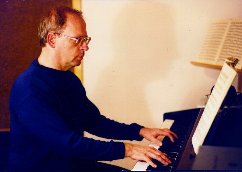
Introduction and technical information

The present interpretations are in no way conventional recordings. The works were entered note for note in a MIDI sequencer and provided with all the necessary attributes, such as strength of attack, dynamics, tempo, etc., that are necessary for a musical interpretation. The results of this process were then stored in MIDI format. MIDI format is extremely economical in terms of memory requirements, and therefore especially suitable for transmission over the Internet. Since this format is only capable of recording the instructions for the reproduction of the music, and not the sound itself, the sound produced is dependent to a great degree on the output device (for example, the sound card of a PC). For the production of audio formats, the music is played through a digital or virtual piano and recorded. For the preparation of the MP3s, I employ the parameters 44.1 Hz and 128 kBit/s, which yields a compression of ca. 1:12 in comparison to audio format. The final result comes very close to CD quality -- yet it is not CD quality, since compromises have to be made (in particular, in the overtone range) for the compression. In addition, I also make the works available on CD to let them be heard in the original sound, without any loss of tonal quality. The following table is a summary of the various formats:
| Format | Characteristics | Advantages | Disadvantages |
| MIDI | Contains the instructions for the reproduction of the music, but not the sounds themselves | Extremely economical in terms of memory requirements Post-production editing possible with the MIDI sequencer | Sound dependent on the listener's output device |
| MP3 | Compressed audio format (ca. 1:12) | Almost CD quality Economical in terms of memory requirements in comparison to audio format | Compromises in sound quality, especially in the overtone range |
| Audio | Recording of the original sound | No loss of sound quality | Demands large memory capacity |
That which is described here in a few words is an exceptionally complicated and laborious process, comparable in some ways to the production of an animated film in which tiny individual movements are pieced together to form a flowing sequence of motions. Anybody who has attempted to produce music in this fashion knows how miserable the first attempts sound. Once you learn how to effectively use the means and parameters available, you realize what a powerful tool you have at your disposal, a tool with which astonishing results can be achieved. It naturally takes a while before the first acceptable interpretations come about. And, of course, not all the nuances of a live performance, which is an extraordinarily complex tonal structure, can be reproduced. With the help of the technique described here (step-sequencing), it is however possible to achieve a high degree of approximation, and to make the character of the work audible.
In contrast to this we have live recording (realtime sequencing), which is a method preferred by pianists. The product is a MIDI sequence that directly reproduces the live performance of the player. The representation of the notes in MIDI format does not follow in accordance with the rhythm, however. My interpretations (MIDI, MP3, CD) were created using the step sequencing process exclusively.
About me
I was born in 1948 in Potsdam, Germany. In the family in which I grew up, we often made music. So it was really a matter of course that I learned to play several instruments. I played in small ensembles, and enjoyed studying the scores of large orchestral works. Besides music, I developed a decided inclination toward mathematics, which I ultimately chose as my major at Heidelberg University. Till 2009 I was employed as technical controller in a large company in Munich.
In 1996, I discovered that with the help of MIDI it was possible to interpret works without having to play them. I found this possibility so fascinating that I delved intensively into the interpretation of piano music. I noticed that there are many possibilities of creating a lively interpretation out of one that at first sounds stiff and synthetic. Since 1997, I have placed MIDI sequences on the Internet, initially in public MIDI archives, later, on my own web site, making them available free of charge to all classical music lovers. Since 1999, I have also offered the works in MP3 format and since 2007 in OGG Vorbis format in addition.
My equipment
My equipment consists of a PC with a Soundblaster Live Card. For the creation of the MIDI sequences, I employ Sonar 2. For recordings in audio format, I have a Roland HP 330e digital piano at my disposal.